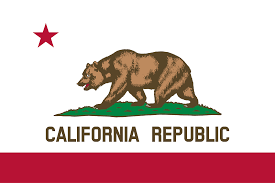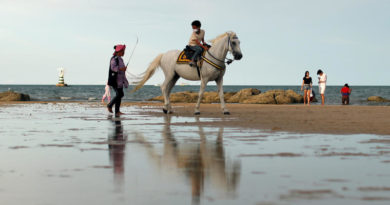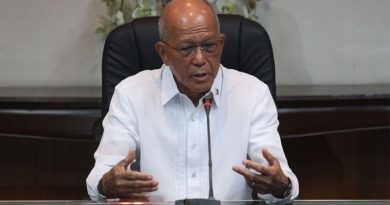| Good morning, and welcome to the Essential California newsletter. It’s Thursday, April 29, and I’m writing from Los Angeles.
Los Angeles, as the writer Octavia Butler once mused in a notebook, “forms and shatters, forms and shatters.”
This has never been a place with a conventional relationship to its history.
Where little blue plaques and carefully preserved structures have proliferated elsewhere, L.A.’s official stance on the past has typically been both grander and more opaque — heavily romanticized, carefully edited, booster-ized, whitewashed and perpetually repackaged in service of whatever comes next.
“We have always had our civic gaze fixed on the future,” Christopher Hawthorne, the city’s first chief design officer and a former Times architecture critic, told me. “To the extent that we have had a coherent sense of identity, it has been very much shaped by that perspective.”
But what about the past? And how to make sense of it?
In late 2019, an official Civic Memory Working Group impaneled by Mayor Eric Garcetti — a diverse array of thinkers that included 40 leading historians, architects, artists, indigenous leaders, city officials, scholars and cultural leaders, according to the city — began meeting to explore how Los Angeles could more accurately reflect the brightest and darkest moments of its history. Hawthorne coordinated the group’s efforts, and earlier this month, it released its recommendations.
[Read more: “Los Angeles wants future monuments and memorials to more accurately reflect its history” in the Los Angeles Times]
The 166-page report, produced by the Huntington-USC Institute on California and the West with support from the Getty Foundation, “begins with a simple provocation in the form of a question: What might it mean if the city of the future could simultaneously be lauded for its regard for the past?”
The group’s recommendations include building a memorial to the victims of the 1871 Anti-Chinese Massacre, appointing an official city historian, looking into the creation of a city museum, an audit of monuments on publicly accessible land and developing strategies to recontextualize or remove those that are outdated or fraught.
I spoke to Hawthorne about the Civic Memory Working Group and the sometimes slippery nature of L.A. history.
Here’s some of our conversation, condensed and lightly edited for clarity.
I know the working group first convened in November 2019, but I imagine the idea was probably simmering long before then. Can you walk us through how it came to fruition?
It was something I was interested in trying to pull together pretty soon after I joined the mayor’s office in April 2018. At that point, there was already beginning to be a national conversation about what to do with controversial monuments and memorials, particularly Confederate monuments. I was interested in what that conversation meant for Los Angeles. Of course, we don’t have Confederate monuments to the same degree, but we have plenty of fraught monuments and memorials that reflect a complicated relationship with history.
So I wanted to see if we could frame some of these questions in a way that was specific to Los Angeles and its particular — and I would say even peculiar — relationship to history. And when I say peculiar, I mean that we have arguably been more aggressive in clearing or whitewashing difficult aspects of our history than most American cities, even.
Why is that?
There are a number of reasons. I think we have relied to an unusual degree on boosterism and mythmaking in establishing our civic identity, particularly in terms of establishing an Anglo elite here in the late 19th and the early 20th century. We have been very much in love with our reputation as the city of the future. We have been headquarters of the Hollywood dream factory.
I know the group was already deeply engaged in discussion about monuments and erasure last summer, when the broader cultural reckoning around these issues hit an inflection point. Did that shape or affect your work?
It added to the urgency. And the sense that the work was timely and it was a good thing that we had done some of the work already, so we weren’t solely being reactive to what was happening. But we could try to incorporate discussions about that “reckoning,” because that was a word that we had been talking about already.
Most specifically, we talked a lot about how the suffering we were seeing around the city last year — public health suffering related to COVID-19, suffering related to racial and other kinds of injustice — had deep roots.
It’s difficult to really understand the unequal toll that the COVID-19 pandemic was taking on the city, for example, without understanding some of the historical forces that we had been talking about and trying to grapple with — whether that’s redlining housing policy, freeway construction, the ways in which the city actively sorted residential populations, often by race, across much of the 20th century.
So both the racial and social justice protests and the pandemic reflected a need for us to understand our history more clearly — particularly the parts of our history that we’ve tried to put aside.
[Read “Past Due,” the L.A. Mayor’s Office Civic Memory Working Group report]
And now, here’s what’s happening across California:
Authorities in the Bay Area city of Alameda are facing growing outrage after a body-camera video released this week showed a police officer appearing to put a knee on the back of a 25-year-old Latino man for more than four minutes, with the man pleading and gasping for air before dying. Mario Gonzalez can be heard saying, “I didn’t do nothing, OK?” before losing consciousness. Family members have compared his death to George Floyd’s. Los Angeles Times
Note: Some of the sites we link to may limit the number of stories you can access without subscribing.
.
Ads by: Memento Maxima Digital Marketing
@[email protected]
SPACE RESERVE FOR ADVERTISEMENT
|
L.A. STORIES
Behind the new show “Them” is the ugly and true history of L.A.’s racist housing covenants. The all-too-common housing covenants restricted who could buy homes in certain neighborhoods in Compton, around Southern California and elsewhere. Los Angeles Times
How to navigate the reopening of L.A. schools: Join columnist Sandy Banks Thursday evening as she moderates a free discussion with Los Angeles Times education reporters Paloma Esquivel, Howard Blume and Sonja Sharp about what to expect as schools reopen. Eventbrite
What’s 10% of $24 a share? Endeavor Group Holdings, owner of talent agency WME, will begin trading shares Thursday on the New York Stock Exchange, marking their long-awaited IPO and one of the highest-profile Hollywood stock offerings in recent years. Los Angeles Times
Support our journalism
Subscribe to the Los Angeles Times.
IMMIGRATION AND THE BORDER
How a photo and a Long Beach book drive led to a false story and attacks on Kamala Harris: As Long Beach repurposes its convention center to house up to 1,000 unaccompanied migrant children temporarily, officials launched a drive to fill a library with books for the children to read. Someone donated a copy of Vice President Kamala Harris’ 2019 children’s book “Superheroes Are Everywhere,” which was photographed on a cot by a news service photographer. The New York Post then wrote a front-page story erroneously reporting that federal officials were including the book as part of “welcome kits” given to migrant children. No books were included in such kits, officials say. Los Angeles Times
POLITICS AND GOVERNMENT
President Biden’s first address to a joint session of a masked and socially distant Congress: In his speech Wednesday, Biden was deliberate in his framing of a historically ambitious agenda that would vastly expand the role of government and rebalance who pays for it. His plans include free community college for all, universal prekindergarten, an expansion of the Affordable Care Act and 12 weeks of guaranteed paid family leave for all Americans. Los Angeles Times
Who wants to recall Gov. Newsom? Signatures point to Trump’s California. Though petitions were signed all across the state, the highest concentrations of signatures were found in the rural northeast, areas with low coronavirus case counts and where voters heavily favored former President Trump. Los Angeles Times
.
Ads by: Memento Maxima Digital Marketing
@[email protected]
SPACE RESERVE FOR ADVERTISEMENT
HEALTH AND THE ENVIRONMENT
Drone photos over Lake Oroville illustrate the drought emergency in Northern California. Water levels at Lake Oroville have dropped to 42% of its capacity, as the region’s reservoirs are in even worse shape than during the severe 2012-16 drought. Los Angeles Times

Houseboats are dwarfed by the steep banks of Lake Oroville on Tuesday. (Justin Sullivan/Getty Images)
CALIFORNIA CULTURE
California’s new ethnic studies curriculum is being put to an early test in Orange County, where organizers are riling up parents in the Los Alamitos Unified School District to oppose elective coursework and materials they say promote divisive, antiwhite rhetoric. Los Angeles Times
He tried to cash in on the NFT craze by auctioning a California house. It did not work. CNN Business
[See also: “$69 million for digital art? The NFT craze, explained” in the Los Angeles Times]
A mere 40 years ago, the U.S. was “a goat cheese wasteland.” Then a small Sebastopol farm and its owner Jennifer Bice “changed everything.” SFGATE
A guide to Disneyland’s reopening: More than a year after closing due to the pandemic, the theme parks at the Disneyland Resort in Anaheim reopen Friday. Los Angeles Times
A poem to start your Thursday: “The Other Life” by Raymond Carver. Unsettlers
Free online games
Get our free daily crossword puzzle, sudoku, word search and arcade games in our new game center at latimes.com/games.
CALIFORNIA ALMANAC
Los Angeles: profligate sunshine, 88. San Diego: similarly sunny but you’ll be in San Diego, 79. San Francisco: partly cloudy, 61. San Jose: dueling sun and clouds, 77. Fresno: heavily sunbaked, 93. Sacramento: loitering clouds, 91.
AND FINALLY
Today’s California memory comes from Marcy Sheinwold:
I was a New York transplant nine years ago, and three simple things struck me as a newcomer and reinforced the feeling that I had come to the promised land. The first were toilet seat liners — how many bathrooms had I dreaded in New York. Second, as a disabled person, I did not have to pay parking fees upon showing my handicapped parking permit. Third, I simply did not hear car horns — the New York cacophony was gone. While there are other blessings including my family here, these simple things welcomed me, and I love living here.
If you have a memory or story about the Golden State, share it with us. (Please keep your story to 100 words.)
Please let us know what we can do to make this newsletter more useful to you. Send comments, complaints, ideas and unrelated book recommendations to Julia Wick. Follow her on Twitter @Sherlyholmes. |















